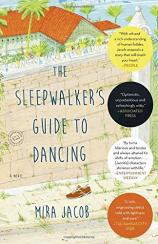The Sleepwalker's Guide to Dancing
Review
The Sleepwalker's Guide to Dancing
Reading debut novels always provides a challenge to the thinking reader, as one is not able to fall back on being either quietly disappointed or pleasantly surprised; the feelings so reassuringly familiar when reading a new work by an author on which we already have firm opinions are totally inaccessible. One is required instead to generate a reaction off the cuff that, as any dinnertime speaker will tell you, wracks the nerves and upsets the digestive system. Mercifully, Mira Jacob’s delightful first novel is uncommonly easy to like, right from the very first pages.
"Mira Jacob’s delightful first novel is uncommonly easy to like, right from the very first pages.... While the elements of the grieving family are familiar enough on paper...there is sufficient nuance in Jacob’s handling for her to forge these characters as uniquely her own."
THE SLEEPWALKER’S GUIDE TO DANCING is a saga centering on the Eapen family, who have emigrated from India to America. The protagonist, Amina Eapen, is a sometime photojournalist now living in Seattle. Her promising career taking “serious” photographs seems to have come to a premature end, and she is hiding out in the less glamorous world of wedding photography. Comedy ensues. Meanwhile, her middle-aged father, Thomas, is back in her adolescent home of Albuquerque and has taken to sitting on his front porch, passing the nights chattering away to the ghost of his long-dead mother. As Amina plans to return to her family home to visit her ailing father, we are drawn back into the Eapen family’s history, stretching beyond Albuquerque to Salem India, and to the intersection of the family’s traumatic past and its critical present.
The conflicts in the novel are eternal ones --- the pull of the old world versus the new, the responsibilities we have to the living versus those we have to the dead. Yet the way these conflicts play out --- a teenaged Indian boy fuming at the decision to cast Ben Kingsley as Gandhi, young women faced with the question of whether or not to marry according to their parents’ ethnically drive view of a good match --- keeps the narrative firmly grounded in the mundane. In this way, Jacob deftly fulfills Flannery O’Connor’s doctrine that “There are two qualities that make fiction. One is the sense of mystery and the other is the sense of manners.”
Speaking of “manners,” one of Jacob’s strengths is her handling of the vernacular; the particularly Indian English of the parents’ generation is set against the more American colloquialisms of Amina and her contemporaries. Kamala, Amina’s mother, whose fervor to see her daughter married rivals Mrs. Bennet’s, charms us with her idiosyncratic variations on English idioms. When trying to dismiss the importance of something, she says, “No big deals,” and when complaining of the promiscuity of American twenty-somethings, she cites the way her niece is always “opening relationships.”
The central trauma around which the novel turns is the death of Amina’s brother, which occurs some years before the narrative begins. While the elements of the grieving family are familiar enough on paper --- an overbearing mother, a more reticent father, a daughter who is dutiful to the point of self-sabotage --- there is sufficient nuance in Jacob’s handling for her to forge these characters as uniquely her own. Just like Kamala’s idioms, they steer dangerously close to the formulaic but remain comically surprising. THE SLEEPWALKER’S GUIDE TO DANCING is a thoroughly enjoyable read.
Reviewed by Frederick Lloyd on July 25, 2014
The Sleepwalker's Guide to Dancing
- Publication Date: June 9, 2015
- Genres: Fiction
- Paperback: 528 pages
- Publisher: Random House Trade Paperbacks
- ISBN-10: 0812985060
- ISBN-13: 9780812985061





